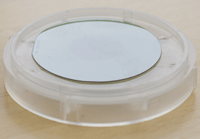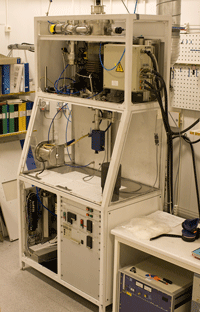- News
9 March 2012
Graphensic spun off from Sweden’s Linköping University for graphene-on-SiC epi
The researchers Rositza Yakimova, Mikael Syväjärvi and Tihomir Iakimov of Sweden’s Linköping University have founded the spin-off Graphensic AB (part of the business incubator LEAD) as what is claimed to be the first European supplier of epitaxial graphene on silicon carbide (SiC).
 The research team has worked on SiC growth processes over many years, and since the early 1990s has developed various growth methods, from epitaxy to bulk. The patent-pending method that has been developed is said to work at higher temperature than competing processes. High quality is achieved through an understanding of the activity of silicon and carbon on the surface.
The research team has worked on SiC growth processes over many years, and since the early 1990s has developed various growth methods, from epitaxy to bulk. The patent-pending method that has been developed is said to work at higher temperature than competing processes. High quality is achieved through an understanding of the activity of silicon and carbon on the surface.
During its research the team supplied material to several projects, both national and European. Professor Yakimova (team leader, and CEO of Graphensic) says this shows that there is an existing demand for the firm’s material for the development of applications. A benefit of SiC is that the wide-bandgap compound semiconductor may be conductive or semi‐insulating, depending on requirements of the specific device developed by users.
 The research team started working with graphitic materials in 2002, resulting in the existing High Temperature Graphene Process (HTGP) for growing epitaxial graphene on SiC, where the higher growth temperatures is said to provide better material uniformity. The first product is monolayer graphene on the silicon face of hexagonal SiC. The firm is also developing bilayer graphene. The research will continue developing new materials in the academic environment in parallel with the industrialization of graphene.
The research team started working with graphitic materials in 2002, resulting in the existing High Temperature Graphene Process (HTGP) for growing epitaxial graphene on SiC, where the higher growth temperatures is said to provide better material uniformity. The first product is monolayer graphene on the silicon face of hexagonal SiC. The firm is also developing bilayer graphene. The research will continue developing new materials in the academic environment in parallel with the industrialization of graphene.
Graphensic’s founders hope that the research will be further supported by the EU-funded ‘Graphene Flagship’ project (for which six ICT projects have been chosen to compete for funding, of which two will be selected this summer), potentially involving €1bn in support over the next 10 years. Graphensic’s first customers come from the Nordic countries, France and Japan. Graphensic also targets supplying industrial groups, says Syväjärvi, who worked on the entrepreneurial steps to launch the start-up. Such firms have much greater demands and are hence useful for Graphensic to work further on its process and materials, he adds.
“We are developing a process for cubic SiC, and study the combination of this material with the graphene,” says Yakimova. “There are many fascinating processes and insightful knowledge in this combinatorial materials system. We hope that these can be a part of our product portfolio in the company,” she concludes.

